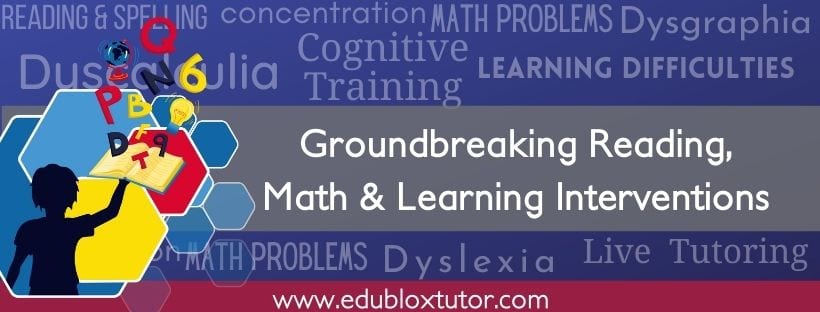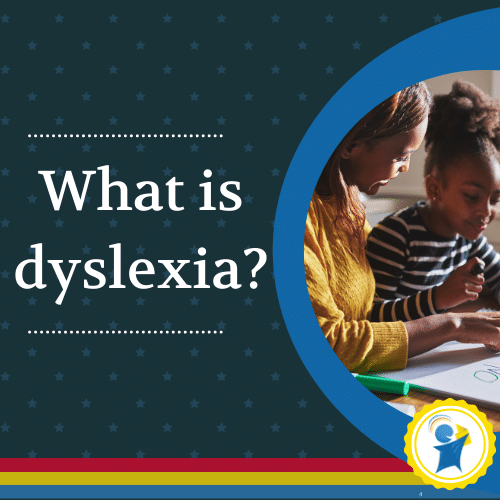
Dyslexia, according to the Diagnostic and Statistical Manual (5th edition), is a specific learning disability not caused by any profound sensory, neurological and intellectual disorders or socio-cultural factors.
Specific learning disabilities interfere with students’ ability to listen, think, speak, write, spell, or do mathematical calculations. Because a learning disorder is a multifaceted problem, it’s not always straightforward to determine if one is present. In this respect, dyslexia is very different from a disease or medical disorder.
Table of contents:
- How a dyslexia diagnosis is made
- What is the difference between dyslexia screening and dyslexia testing?
- Who can make a dyslexia diagnosis?
- What happens after a dyslexia test?
- What are the different types of dyslexia?
- What causes dyslexia?
- Helping your child overcome dyslexia
.
How a dyslexia diagnosis is made
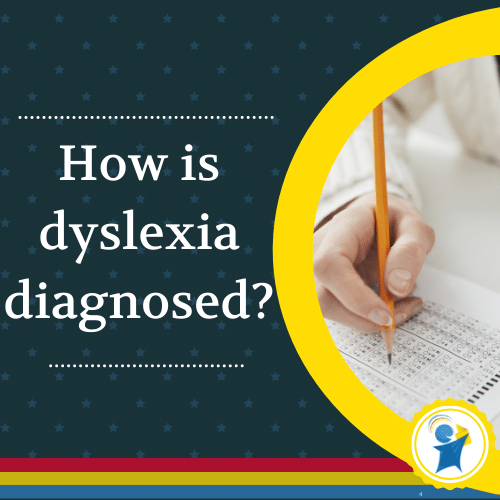
A diagnosis of dyslexia can only be made after an extensive evaluation, which usually includes an intelligence test like the Wechsler Intelligence Scale for Children. This evaluation also looks at a child’s reading ability and other factors such as general academic ability and family background.
Typically, a large amount of information is required, and the person administering the evaluation will take the child through a series of tests. This thoroughness is necessary because it’s important to rule out other possibilities, such as intellectual impairment and vision problems. Neither of these is the same as dyslexia.
Some of the components that go into a comprehensive educational evaluation are:
– Tests of hearing and vision
These tests can rule out that a child has difficulties on the physical level. Naturally, vision or hearing problems will be severely disruptive to the learning process.
– Developmental histories, sociological and emotional background
An assessor will be interested in any issues in a child’s development, whatever their nature. Even physical milestones such as crawling can be relevant here. Other important factors are the child’s school and home life and the ability to regulate emotions.
– Tests of specific skills
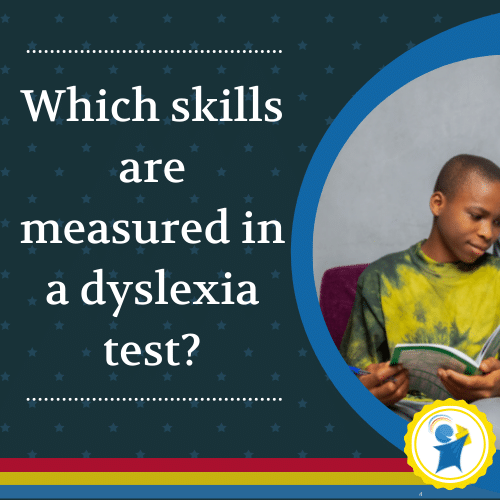
In the course of an assessment, the child will work through a variety of tests. The tests administered gauge skills like
- Phonological processing, which comprises phonological awareness and phonemic awareness. Phonological awareness refers to an individual’s awareness of the sound structure of language, while phonemic awareness is a subset of phonological awareness that focuses on recognizing and manipulating phonemes, the smallest sound units.
- Decoding is the ability to apply your knowledge of letter-sound relationships, including knowledge of letter patterns, to pronounce written words correctly.
- Reading fluency requires effective word recognition skills. Word recognition is the ability to recognize whole words instantly by sight without sounding them out.
- Reading comprehension refers to a reader’s ability to successfully interpret a text and connect the ideas in the text to their background knowledge. Because they have difficulty with decoding and fluency, students with dyslexia typically score low on reading comprehension tests.
- Vocabulary knowledge is one of the most significant contributors to reading comprehension. Research suggests that vocabulary knowledge contributes 50 percent to 60 percent of the variance in reading comprehension outcomes.
- Oral language skills include speaking and listening. Research suggests they are not only essential for learning to read, but the relationship between oral language abilities and reading is also reciprocal.
- Rapid naming requires the child to look at familiar objects, letters, or numbers and name them quickly.
- Working memory is the mental ability to store and manipulate information temporarily.
The clinician collates and interprets all of this information to determine whether learning disabilities exist. The assessment results will also be used to give recommendations regarding the nature and extent of the educational interventions the child will need to overcome significant challenges.
What is the difference between dyslexia screening and dyslexia testing?
If you are considering getting an assessment for your child, you have likely noticed signs of a reading problem, trouble learning, or poor school performance. Once a parent, other family members, or the child’s teachers notice these signs, it’s a good idea to investigate.
There are two methods for determining the nature and extent of a learning difficulty: screening and assessment.
Screening is a method for identifying children who are at risk. This usually takes the form of a brief test. The results are useful but inconclusive. These tests are, by their nature, not specific enough to justify a diagnosis.
In contrast, a formal dyslexia assessment is a personalized, detailed process that aims to paint a picture of a particular child’s strengths and weaknesses.
Who can make a dyslexia diagnosis?
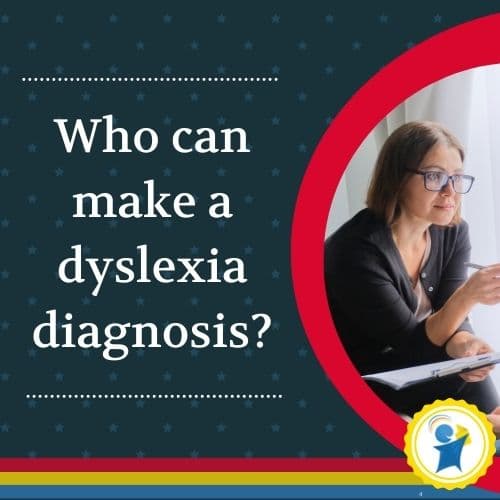
In many countries, the ability to diagnose dyslexia is limited to certain qualified professionals. No overarching law defines who may provide a diagnosis in the United States. Generally, however, there is an understanding that one test on its own cannot be an adequate basis for a dyslexia diagnosis. Clinicians who typically give dyslexia diagnoses use a battery of tests. A medical or physiological report may be integral to that process but not sufficient on its own.
These are the professionals who most commonly issue diagnoses or can acquire institutional support for dyslexia:
– Educational or school psychologist
Educational psychologists and school psychologists are interested in how children absorb and process information and are tasked with assessing children for learning disorders.
– Neuropsychologist
A neuropsychological assessment is a detailed evaluation to determine the presence, nature, and severity of cognitive dysfunctions. The goal is to establish whether a child’s cognitive abilities are adequate for the demands of mainstream education.
– Speech-language pathologist
Because dyslexia concerns the act of reading, specialists in language acquisition are well-placed to address it. They are often involved in a cluster of professionals who provide input on assessments of a child’s linguistic competence.
– Occupational therapists
While occupational therapists usually play a direct role in dyslexia treatment, they can also contribute to diagnoses in some cases. They have specific expertise in the management of the environment for learning. For example, they observe how a child sits, stands, and engages with the classroom.
– Other
An optometrist test is an easy way to determine whether a child’s vision is normal or deficient. Optometrists can test your child’s eyesight and check whether the eyes function normally. Similarly, an audiologist can assess your child’s hearing to confirm that no hearing impairment is present.
These are essential first steps before seeking a dyslexia test, because the assessor will want to know that your child has no physiological deficits.
What happens after a dyslexia test?
If your child is diagnosed with dyslexia after undergoing a comprehensive assessment, you may experience relief. You finally have an answer to the question of why your child is not performing well at school. But the news can also evoke dread and fear. Understandably, you may worry that dyslexia will be a lifelong obstacle. The good news is that this need not be the case. Here are some things that you can do if you are in this situation:
– Get an Individualized Education Plan (IEP) in place
Dyslexia is classed as a specific learning disability. This means that a dyslexic child is entitled to additional support where necessary. In the United States, this is known as an Individualized Education Plan (IEP).
If your child does not qualify for special accommodations at school but has received a professional diagnosis of dyslexia, you can make use of Section 504 of the Rehabilitation Act, 1973. It is an alternative avenue to acquire additional services for your child, such as extra time on tests or educational support in the classroom.
– Identify and nurture your child’s strengths
A child diagnosed with dyslexia may experience emotional distress, either from knowing about the diagnosis or perceiving their limitations at school. A great way to offset this is to focus on your child’s strengths, whatever they may be, to restore confidence and build your child’s self-esteem.
– Consider online tutoring for dyslexia
Edublox offers live online tutoring to students with dyslexia, dyscalculia, dysgraphia, and other learning difficulties.
Watch our explainer video below and visit our Testimonial Page for many stories on how Edublox training and tutoring have helped turn dyslexia around. Book a free consultation to discuss your child’s learning needs.
What are the different types of dyslexia?
You can think of a “type” of dyslexia as an indication of which skills your child needs to develop rather than a diagnosis. Children commonly show signs of both types of dyslexia.
– Phonological dyslexia
One of the most common forms of dyslexia is called phonological dyslexia. As its name suggests, this dyslexia type is connected to sound.
Every language has a set of sounds that you have to know in order to speak it. These sounds are called phonemes. However, it’s not enough to be able to say phonemes to read and write a language. You also need to be able to link them to symbols. Decoding happens when you see a symbol and convert it into the correct phoneme. A child with phonological dyslexia finds it hard to do this.
– Surface
For some people, the difficulty is not sound-based but more visual. For example, a child may find it hard to recognize a word, even if it’s not the first time they have seen it. For a proficient reader, the shapes of words are immediately recognizable, almost like the faces of familiar people. If a child scores poorly on the sight word module of a dyslexia test, the problem may well stem from an inability to recall these shapes.
One of the hallmarks of this kind of dyslexia is the frequent confusion of letter symbols that look similar. For example, a child may not always distinguish “b” from “d.”
What causes dyslexia?
We aren’t yet sure whether dyslexia and the brain behaviors that seem to occur alongside it are determined by genes or caused by events in childhood development. The current consensus is that both are possible, and both exist in the population of dyslexic people.
– Primary dyslexia
Clinicians have known for a long time that dyslexia runs in families. This means if a child has a parent with dyslexia, they are more likely to have the learning disorder. Primary dyslexia refers to dyslexia when it is the result of a genetically inherited condition.
– Secondary dyslexia
On the other hand, dyslexia can be caused by events that take place during infancy. In this case, it is not primary but secondary dyslexia.
Some experts theorize that certain influences can prohibit a child from developing language skills. These are as wide-ranging as a mother’s behavior during pregnancy, a failure to crawl, or even emotional and social conditions.
Helping your child overcome dyslexia
Even if there is a genetic basis for your child’s reading difficulties, this does not mean that the condition is untreatable or that your child will always struggle to learn.
A factor to bear in mind is the role of neuroplasticity. Throughout life, the brain creates new neuronal networks in response to training and education. This is what happens to the brain of a child who undergoes reading interventions to improve their reading skills.
There is now a great deal of evidence that suggests the outlook for a child with dyslexia can be significantly improved, especially if problems are identified and dealt with early on.
Authored by Susan du Plessis (B.A. Hons Psychology; B.D.), a reading specialist with 30+ years of experience in learning disabilities, and Dylan Arslanian (B.A. Hons Linguistics, Cambridge DELTA).
Medically reviewed by Dr. Zelda Strydom (MBChB).

